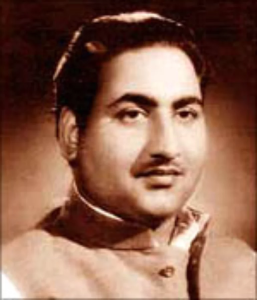Introduction: The Birth of a Musical Icon
 On December 24, 1924, the music world witnessed the emergence of a legendary figure, Mohammed Rafi, in the quaint village of Kotla Sultan Singh, situated close to Amritsar, Punjab.
On December 24, 1924, the music world witnessed the emergence of a legendary figure, Mohammed Rafi, in the quaint village of Kotla Sultan Singh, situated close to Amritsar, Punjab.
Known affectionately as Pheeko, this fifth child of Haji Ali Mohammed and Allahrakhi Bai was destined for greatness in the expansive realm of Indian music. This article explores the humble beginnings and formative years that shaped the iconic voice of Mohammed Rafi.
The First Spark of Melody
Rafi’s musical odyssey commenced with the captivating chants of a fakir in his village. The melodic tunes would make him follow the fakir for long distances, imitating his chants upon return. Impressed by Rafi’s mimicry, the fakir bestowed his blessings, prophesying that the young boy would shine like a star. This early encounter foreshadowed his profound impact on the world of melodies.
Formal Training in Indian Classical Music
Despite his father’s initial disapproval of music due to conservative beliefs, Rafi’s talent was recognized by Abdul Hameed, a friend of his elder brother. Abdul Hameed’s conviction convinced the family to permit Rafi to pursue music, leading him to formal training in Indian Classical Music under Pt. Jiwan Lal Mattoo. Further guidance followed from Ustad Abdul Waheed Khan of Kirana Gharana, Ustad Bade Ghulam Ali Khan, and Feeroz Nizami, a producer at All India Radio, Lahore, establishing a strong classical foundation for his versatile voice.
Serendipitous Stage Debut and Shyam Sundar’s Discovery
Rafi’s debut as a stage performer occurred serendipitously at the age of 13 during a power failure at a live performance by the legendary singer Kundan Lal Saigal. Seizing the opportunity, Rafi’s brother Hamid persuaded organizers to let Rafi entertain the crowd until power was restored. His spontaneous musical showcase on that day drew the keen interest of the accomplished music composer Shyam Sundar. Recognizing Rafi’s exceptional talent, Sundar extended an invitation for him to relocate to Bombay and embark on a promising musical journey.
Moving to Bombay and First Recording
In 1944, at the age of 20, Rafi, with the support of his family, moved to Bombay with Abdul Hameed. Settling in a modest ten by ten feet room in Bhendi Bazar, a vibrant suburb in Bombay, Rafi’s promise materialized as Shyam Sundar recorded his first song, “Soniye Hiriye, Teri Yaad Ne Aan Sataya …”, for the Punjabi film Gul Baloch. Poet Tanvir Naqvi then introduced Rafi to film luminaries like Abdur Rashid Kardar, Mehboob Khan, and actor-director Nazeer, expanding his presence in the Indian film industry.
A New Chapter Begins
That pivotal moment set up a new chapter, marking the beginning of Rafi’s illustrious life and career. The song “Soniye Hiriye …” caught the attention of various music directors and promptly propelled Rafi into the limelight, setting the stage for his unparalleled ascent in Indian playback singing.
Exploring Rafi’s Enduring Musical Legacy
In upcoming articles, by discussing timeless melodies like “Pyar Kiya Hai Aise …”, we will delve deeper into the extraordinary journey of the life and career of the legendary Mohammed Rafi, exploring the milestones, challenges, and the profound musical legacy he left behind for generations to come.
~ Balwant S. Wadhwani
